Chinese Navy Day ! Let’s have a look at the latest, largest and best warship the Chinese Navy ever had: CNS Fujian… Fujian is the first CATOBAR (with EMALS) ever built for the People’s Liberation Army Navy, third aircraft carrier in the new carrier programme, first of the Type 003 class, succeeding to the Type 002 Shandong, a modified Kuznetsov-class and last STOBAR. She is also the first truly indigenously designed carrier, built by the Jiangnan Shipyard, launched on 17 June 2022, with sea trials last year by May 2024. The size of a Nimitz class, this vessel is the first of four carriers intended to be the cornerstone of the PLAN to break the 9-dash line. The next one, Type 004 (still unnamed) would be this time a larger (110,000 tonnes) would be propelled by molten salt nuclear reactors and its first module was reportedly started in last February 2025. It is expected to be completed around 2030, and, if successful, the lead ship of a class of three FY2039.
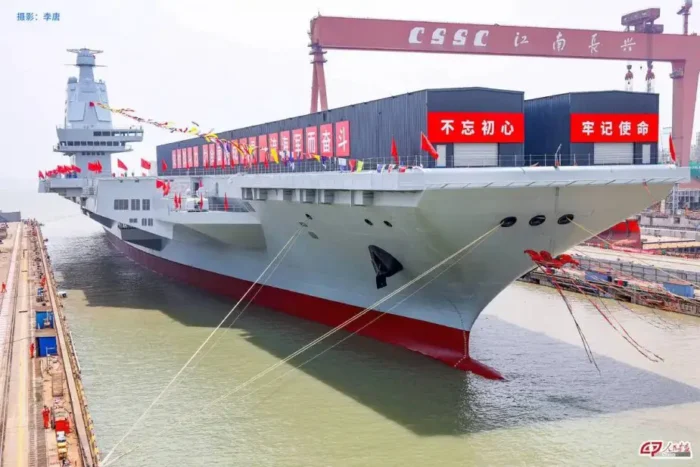
Design of the class
Development
At this early stage and given the level of secrecy assimilated to the Type 003, here are what we have known so far. This carrier was originally designated by observers as Type 002 since at the time, the incomplete Shandong was thought to be Type 001A. Shandong was officially confirmed as a Type 002 when commissioned in December 2019, thus western observers started to call the incomplete Fujian as Type 003. The move towards a CATOBAR was speculated to have been discussed all the way back in 2011-2012 already, as it was already clear that STOBAR carriers had limitations, starting with the inability to launch fully-laden fighter-bombers with ramp. This operational limitation was somewhat alleviated by better management of an air group and the fact it is quicker to launch aircraft via a ramp than to set up catapult launches. But it is still a limitation.
This it was agreed that a new carrier would be built, not with nuclear power, still worked out at the time, but a larger air group, and originally intended to use steam catapults by 2013. PLAN Rear Admiral Yin Zhuo reported however the same year the new carrier would use instead Electromagnetic (EM) catapults. Such prototypes were observed in 2012 and their size mechanically meant having a longer ship. The new 004 was indeed planned to be a 80,000–85,000 t, 316 meters ship, so equivalent to the US Forrestal or Kitty Hawk class of the 1950s for their size and steam plant.
It is understood now the Type 004 is a step-up towards a final design equivalent to current US super carriers such as the new Ford class. She is a prototype, sporting EMALS to just skip the steam catapult stage, but compromising by using a steam plant. Indeed, there again, the PLAN believed probably thinks the PWR (pressurized water cooled reactors) are now an obsolete, potentially dangerous tech. Smaller, simpler and much safer molten-salt tech seems to be the future and thus the next nuclear-powered carriers would use such tech, skipping another step. In fact, since the Ford class and its successors are still going to use PWR technology, that would make the Type 004, the world’s most advanced super carriers.
Fujian (福建舰), named after a famous maritime province, was laid down at Jiangnan Shipyard likely back in March 2015 (first module started), and proper ceremonial keel laying back in February 2016. She was launched n 17 June 2022, so six years later, which for a ship of that size and novelty is not surprising.
Hull and general design
The Type 003 Fujian is a very large design compared to the previous Shandong, but exact specs are still debated. It is estimated she is 316 m (1,036 ft 9 in) long, 76 m (249 ft 4 in) wide, for a full load displacement of 80,000 to 85,000 tons. To compare, the Shandong displaces 60,000-70,000 tons FL for 305 m (1,000 ft 8 in) long, 75 m (246 ft 1 in) in beam. So this suggests designers stretched the previous design forward and modified the flight deck shape, only gaining a meter in extra beam for ten meters longer needed for the catapult reach. The design was tailored to have three catapults, with two forward and one on the port angled landing deck, launching forward. All three catapults has blast deflectors.
The class features a pronounced bulge prow, two port side lifts, and a towering island, smaller than the Shandong-Kuznetsov designs, yet still incorporating modern 3D radar arrays above the bridge, either side of the exhausts pipes. There is an additional mast on top.
Type 003 according to more precise official estimations was recorded as 71,875 tons (70,740 long tons) for a full load displacement of over 80,000 tons (79,000 long tons).
She measures 300 meters (984 feet 3 inches) at the waterline, but 316 meters (1,036 feet 9 inches) overall. The beam at the waterline is 39.5 meters (129 feet 7 inches) but overall reaching 76 meters (249 feet 4 inches) at flight deck level amidships.
Powerplant
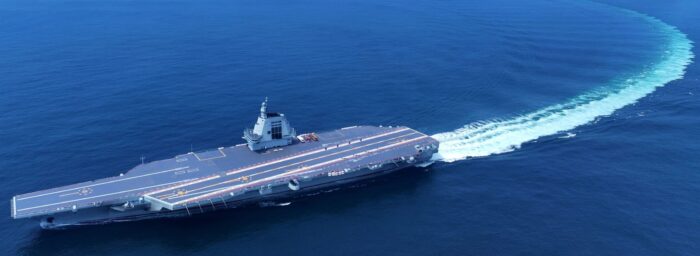
This was for long a great unknown. Some articles in the press stated she even had pressurized water reactors. But it is now asserted in all sources, she is instead sporting conventional steam turbines and diesel generators. She likely had four steam turbines. Some speculated they were of the same type used on the Type 075 landing helicopter dock, but four instead of two. There was even a claim they had up to 24 of the Type 055 destroyers (QD-50 turbine generators (5 MW/6,700 hp) each, 160,000 hp total) connected to an electric transmission. According to army recognition back in 2023, however, she is given a proven power plant with 4 shafts, eight or four turbines fed by 8 boilers and at least four diesel generators for at least over 220,000 horsepower (164MW).
This output is more coherent for the top speed she is supposed to achieve at 30+ knots. It is classified.
Protection
Details are unknown, but we can guess the “usual suspects” are present, here is a list:
Deck armour, integrated into the structure to gain weight, probable kevlar or assimilated inserts to keep the top weight down.
Hangar floor armour, same figures.
Waterline level CO (centra Operation) with kevlar and steel armour
Ammunition Magazine armour, same type, also buried deep.
Hangar fireproof systems: Sprinklers with halon, fire stations and fireproof curtains.
Secured aviation gazoline network with seawater filling, building gases detectors and safety valves, etc.
Full NBC protection with overpressure, sealing, etc.
Full active protection: EW systems, decoy launchers on the bridge and around the deck, perhaps torpedo decoys.
Silencing systems for the powerplant (rafting) and propellers.
Armament
Not precise yet.
Four H/PJ-14 30 mm (1.2 in) CIWS
The H/PJ-14 or Type 1130 is a Chinese 30 mm close-in weapon system (CIWS), used primarily for naval defense against incoming missiles, aircraft, and small surface threats.
Caliber: 30 mm (1.2 in), Gatling-type rotary cannon, 11 11 barrels
Rate of Fire: c10,000 rounds per minute (theoretical), effective ~2,500–3,000 meters (air targets)
Guidance: Radar and electro-optical targeting
Ammunition: High-explosive incendiary, armour-piercing
Naval, turret-mounted, seen also on the Type 052D destroyers, Type 055 cruisers. Currently, the most powerful CIWS systems in service due to its unprecedented rate of fire, which is meant to saturate the airspace with projectiles, increasing the probability of intercepting supersonic anti-ship missiles.
Four HHQ-10 SAM (FL-3000N)
The HHQ-10 (also known as FL-3000N in its export version) Short-range surface-to-air missile (SAM) is a Chinese system designed for point defence against incoming missiles, aircraft, and UAVs. It’s often referred to as China’s equivalent to the RIM-116 Rolling Airframe Missile (RAM) system used by the U.S. Navy. Cose range, CIWS-style missile defence
Specs:
Rotating turret, box launcher (8–24 cells)
Guidance: Passive infrared (IR) & imaging infrared (IIR)
Range; ~9–10 km at Mach 2.0+
Warhead HE-Frag
Sensors
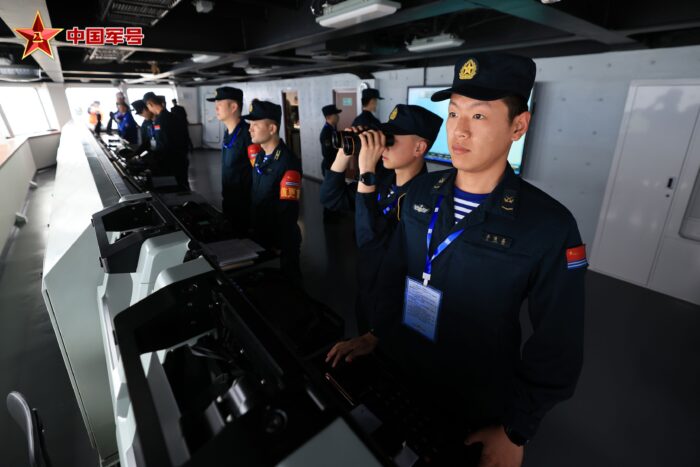
No info so far, we can guess a derivative of the Type 346 S-Band AESA, perhaps 346B or new system, TBD.
Air Group
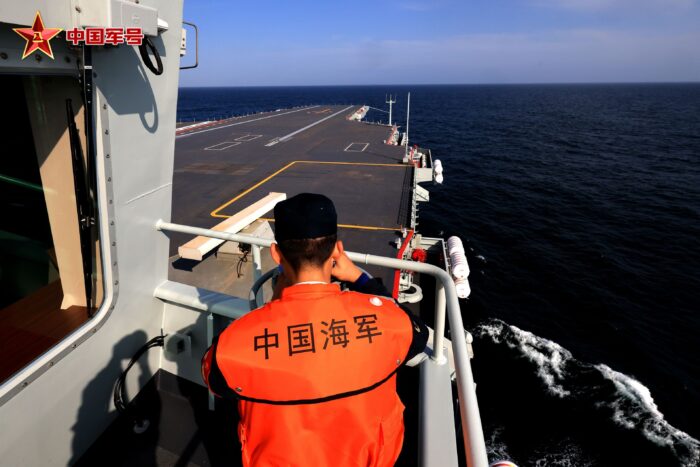
The great advantage of the design, 60 modern aircraft estimated, including 40 fighter-bombers, and c16 helicopters, 4 EAW planes.
Fighter Bombers:
Shenyang J-15:
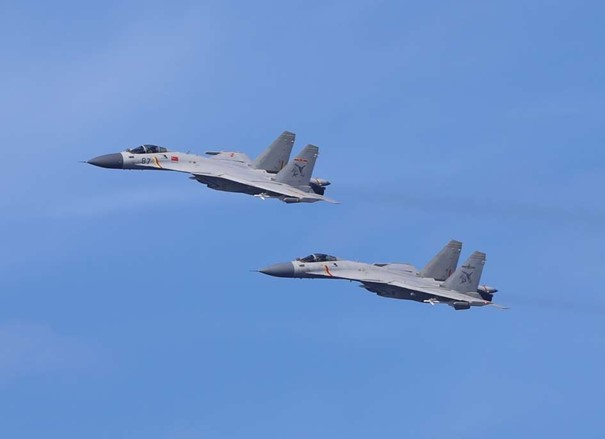
The Shenyang J-15 “Flying Shark” (飞鲨) is likely the main multirole fighter jet in service as completed by 2026, based on the Russian Su-33 airframe but upgraded with Chinese avionics, weapons, and systems. There is already a pool from Liaoning and Shandong operations. Delivered for the Fujian on CATOBAR J-15T version. It is likely to be replaced from 2030 by the J-35.
Specs:
Length 22.3 m (73.1 ft), wingspan 15 m (49.2 ft).
Max TO Weight 33,000 kg (72,750 lbs).
2x WS-10H reactors for ~Mach 2.4 at altitude, range 1,500+ km combat radius with drop tanks.
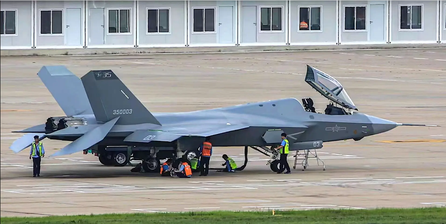
Navalized prototype of the Shenyang J-35 stealth fighter
The Fujian is supposed to operate a combination of J-20 fighers and J-35 Strike Fighter. The latter possesses also torpedo-carrying capabilities and SSMs for anti-ship work.

J-20 at Airshow China. The Shengdu J-20 Mighty Dragon (威龙), is China’s premier 5th-gen. stealth fighter jet, developed by the Chengdu Aerospace Corporation, answer to the F-22 Raptor and F-35 Lightning II, designed for air superiority, stealth strike, and long-range interception. Introduced in 2017 it entered PLAAF service.
Specs:
Length: 20.4 m (66.9 ft); wingspan 13.5 m (44.3 ft).
WS-15 engines, Mach 2.0+ (est.) range 1,100–1,200 km (est.). Ceiling c20,000 m (65,000 ft).
Internal weapons bays, radar-absorbing material for PL-10, PL-15, PL-21 missiles (air-to-air), internal + 2 external hardpoints.
Avionics: AESA radar, EOTS, datalinks, and likely AI-enhanced systems.
Its conversion to a navalized version so far is speculative.
EAW: Xi’an KJ-600

Four of these Hawkey clones (first flight August 2020) were designed to be carried by the Type 003 Fujian. They had a reconfigurable fuselage with rear doors unlike the regular Hawkeye in order to double as cargo and airborne early warning and control (AEW&C). So far four protootypes had been built and tested.
Helicopters:
Harbin Z9: At least four deployed for SAR, from a licenced Eurocopter Dauphin.
Changhe Z-18: Probably around four Chinese version of the French Super Frelon. Standard ASW, transport, EW and mulrirole heavy helicopter since 2018.
Harbin WZ-19 CAIC: At least four, derived from the Z-9 It which entered service in 2012 (200 est. built). They are a navalized attack helicopter that can perform a wide range of mission (crew of 2 in tandem, no cabin).
Fixed-wing drones:

The FL-71 Drone is likely to be deployed. The FL-71 is a stealth UCAV developed for high-speed reconnaissance and strike missions, unveiled by the Aerospace Times Feihong Technology Company (ATFTC), a subsidiary of China Aerospace Science and Technology Corporation (CASC) at the Zhuhai Airshow 2018.
It is Flying wing/blended body with stealth shaping with low-RCS; internal stores, exhaust shielding, powered by a single jet engine with afterburning turbofan with speeds from high subsonic to supersonic, long range.
It has an internal weapons bay for air-to-ground and AAMs, even tactical nukes to performg ISR, SEAD (Suppression of Enemy Air Defenses), or precision strike roles.
It is comparable to the X-47B or nEUROn. Details of operational duties are not known, but it is believed capable of deep strike missions in contested airspace, Intelligence, Surveillance, and Reconnaissance (ISR), loyal wingman to manned fighters, Jamming or SEAD using electronic warfare payloads.
Type 003 specifications |
|
| Dimensions (est.) | 316 x 76 x 9 m |
| Displacement | 80,000/90,000 t FL |
| Crew | 3000+ (2000 crew, 1000 AG) |
| Propulsion | 4 propellers, 4 Steam turbines, 8 boilers, 4 diesels, 220,000 hp |
| Speed | 31 knots (58 km/h; 36 mph), TBD, classified. |
| Range | c6,000 nautical miles |
| Armament | c60 aircraft, see notes |
Current Status
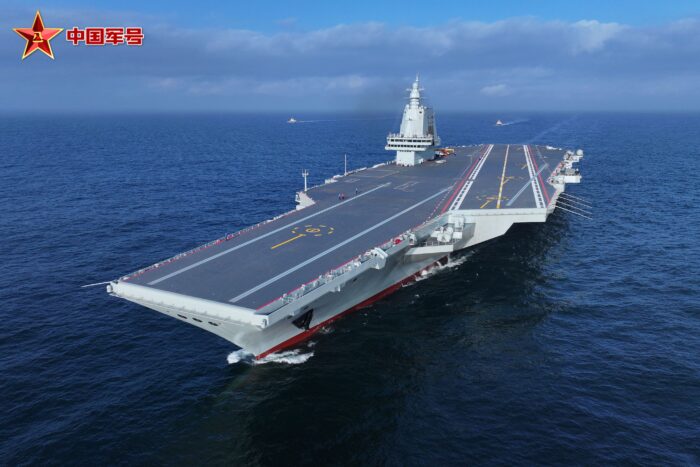
She completed her sea trials back in 2024.
Construction was reported starting back in March 2017, but only modules. Her existence was confirmed by Xinhua News Agency in November 2018. Thanks to satellite images, her hull was identified in construction back in April 2019. After launch in June 2022, back in July, hull components were moved from the initial assembly area to dry-dock for the next construction phases. Sometimes in 2022 she probably started to test some systems while in drydock. By April 2023 she had mooring trials at Jiangnan shipyards, first power trials. By May 2024 on 1-8, she had her first sea trials tests. Notably the energy department, decks, hangar tests, bridge etc. In 24 May to 11 June she had her 2nd sea trials series extensive propulsion tests, hard manoeuvres, top speed runs, etc. In July, 4-26th, she had her 3rd sea trials phase, with the first full scale flight deck and lifts, catapult tests and first aircraft integration. In September, she had EMALS tests with sample aircraft of her future air group. From 18 November to 3 December, she has her 5th sea trials tests with all energy departments and on board electronics, armaments also performing aircraft take-offs, landings and deck operations. She would probably continue to work out this year (2025).
This year is now dedicated to work out her full air group and train initial pre-commission crews to familiarize with CATOBAR operations. This is a first, so the PLAN needs a year to really build up these skills and “write the book” for the Type 004 and next ones. Her pennant number is CV-12.
Since China is also adding to the mix the air group of its upcoming Type 075 landing helicopter docks, 28 helicopters each (4 completed, 8 planned).
She is now officially very close to commission, scheduled to take place probably later this year (back to 2023 it was scheduled for 2026), and this will be quite an announcement on international media, so stay tune !
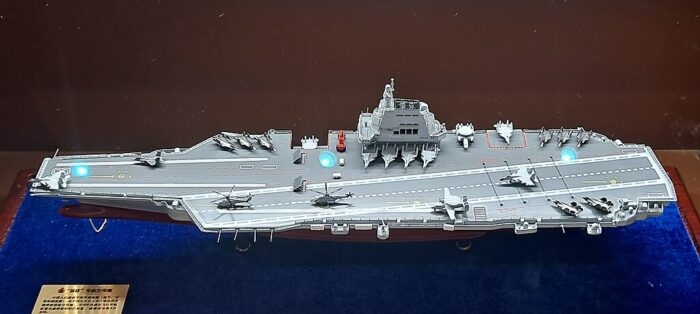

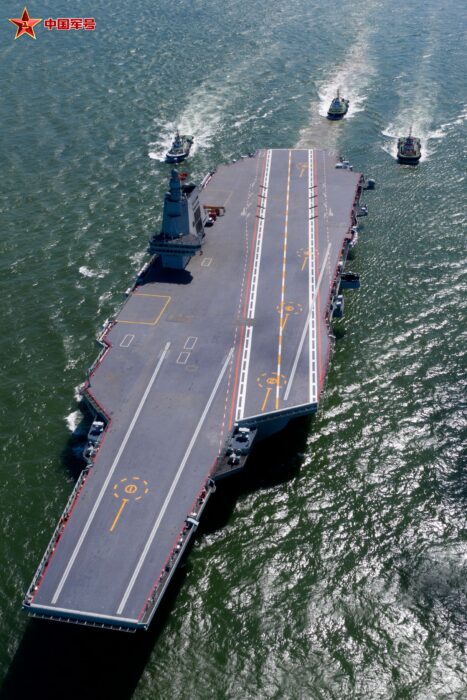
Links/Sources
https://www.naval-technology.com/news/analysis-what-we-know-about-the-fujian-chinas-new-aircraft-carrier/
https://armyrecognition.com/news/navy-news/2023/3rd-china-navy-s-aircraft-carrier-fujian-holds-propulsion-tests
https://www.defenseone.com/ideas/2024/06/chinas-latest-aircraft-carrier-much-more-big-ship/397188/
https://www.iiss.org/online-analysis/military-balance/2024/11/chinas-aircraft-carriers-begin-to-spread-their-wings/
https://en.wikipedia.org/wiki/List_of_ships_of_the_People%27s_Liberation_Army_Navy
https://en.wikipedia.org/wiki/People%27s_Liberation_Army_Navy



 Latest Facebook Entry -
Latest Facebook Entry -  X(Tweeter) Naval Encyclopedia's deck archive
X(Tweeter) Naval Encyclopedia's deck archive Instagram (@navalencyc)
Instagram (@navalencyc)



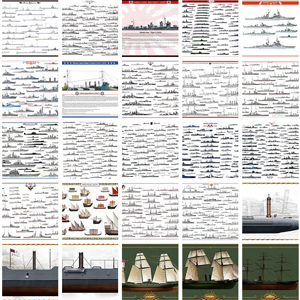

 French Navy
French Navy Royal Navy
Royal Navy Russian Navy
Russian Navy Armada Espanola
Armada Espanola Austrian Navy
Austrian Navy K.u.K. Kriegsmarine
K.u.K. Kriegsmarine Dansk Marine
Dansk Marine Nautiko Hellenon
Nautiko Hellenon Koninklije Marine 1870
Koninklije Marine 1870 Marinha do Brasil
Marinha do Brasil Osmanlı Donanması
Osmanlı Donanması Marina Do Peru
Marina Do Peru Marinha do Portugal
Marinha do Portugal Regia Marina 1870
Regia Marina 1870 Nihhon Kaigun 1870
Nihhon Kaigun 1870 Preußische Marine 1870
Preußische Marine 1870 Russkiy Flot 1870
Russkiy Flot 1870 Svenska marinen
Svenska marinen Søværnet
Søværnet Union Navy
Union Navy Confederate Navy
Confederate Navy Armada de Argentina
Armada de Argentina Imperial Chinese Navy
Imperial Chinese Navy Marinha do Portugal
Marinha do Portugal Mexico
Mexico Kaiserliche Marine
Kaiserliche Marine 1898 US Navy
1898 US Navy Sovietskiy Flot
Sovietskiy Flot Royal Canadian Navy
Royal Canadian Navy Royal Australian Navy
Royal Australian Navy RNZN Fleet
RNZN Fleet Chinese Navy 1937
Chinese Navy 1937 Kriegsmarine
Kriegsmarine Chilean Navy
Chilean Navy Danish Navy
Danish Navy Finnish Navy
Finnish Navy Hellenic Navy
Hellenic Navy Polish Navy
Polish Navy Romanian Navy
Romanian Navy Turkish Navy
Turkish Navy Royal Yugoslav Navy
Royal Yugoslav Navy Royal Thai Navy
Royal Thai Navy Minor Navies
Minor Navies Albania
Albania Austria
Austria Belgium
Belgium Columbia
Columbia Costa Rica
Costa Rica Cuba
Cuba Czechoslovakia
Czechoslovakia Dominican Republic
Dominican Republic Haiti
Haiti Hungary
Hungary Honduras
Honduras Estonia
Estonia Iceland
Iceland Eire
Eire Equador
Equador Iran
Iran Iraq
Iraq Latvia
Latvia Liberia
Liberia Lithuania
Lithuania Mandchukuo
Mandchukuo Morocco
Morocco Nicaragua
Nicaragua Persia
Persia San Salvador
San Salvador Sarawak
Sarawak Uruguay
Uruguay Venezuela
Venezuela Zanzibar
Zanzibar Warsaw Pact Navies
Warsaw Pact Navies Bulgaria
Bulgaria Hungary
Hungary

 Bundesmarine
Bundesmarine Dutch Navy
Dutch Navy Hellenic Navy
Hellenic Navy Marina Militare
Marina Militare Yugoslav Navy
Yugoslav Navy Chinese Navy
Chinese Navy Indian Navy
Indian Navy Indonesian Navy
Indonesian Navy JMSDF
JMSDF North Korean Navy
North Korean Navy Pakistani Navy
Pakistani Navy Philippines Navy
Philippines Navy ROKN
ROKN Rep. of Singapore Navy
Rep. of Singapore Navy Taiwanese Navy
Taiwanese Navy IDF Navy
IDF Navy Saudi Navy
Saudi Navy Royal New Zealand Navy
Royal New Zealand Navy Egyptian Navy
Egyptian Navy South African Navy
South African Navy






























 Ukrainian Navy
Ukrainian Navy dbodesign
dbodesign